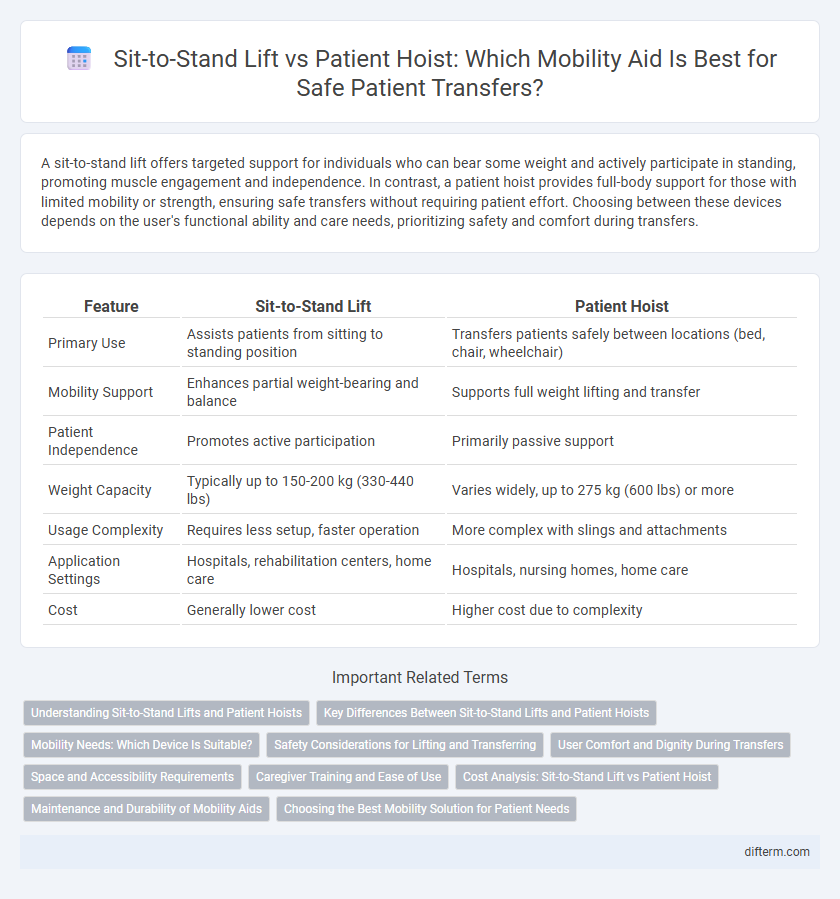A sit-to-stand lift offers targeted support for individuals who can bear some weight and actively participate in standing, promoting muscle engagement and independence. In contrast, a patient hoist provides full-body support for those with limited mobility or strength, ensuring safe transfers without requiring patient effort. Choosing between these devices depends on the user's functional ability and care needs, prioritizing safety and comfort during transfers.
Table of Comparison
| Feature | Sit-to-Stand Lift | Patient Hoist |
|---|---|---|
| Primary Use | Assists patients from sitting to standing position | Transfers patients safely between locations (bed, chair, wheelchair) |
| Mobility Support | Enhances partial weight-bearing and balance | Supports full weight lifting and transfer |
| Patient Independence | Promotes active participation | Primarily passive support |
| Weight Capacity | Typically up to 150-200 kg (330-440 lbs) | Varies widely, up to 275 kg (600 lbs) or more |
| Usage Complexity | Requires less setup, faster operation | More complex with slings and attachments |
| Application Settings | Hospitals, rehabilitation centers, home care | Hospitals, nursing homes, home care |
| Cost | Generally lower cost | Higher cost due to complexity |
Understanding Sit-to-Stand Lifts and Patient Hoists
Sit-to-stand lifts are designed to assist patients who have partial weight-bearing ability, promoting muscle engagement and improving mobility during transfers. Patient hoists provide full support for individuals with limited or no weight-bearing capacity, ensuring safe and secure lifting through slings or harnesses. Choosing between sit-to-stand lifts and patient hoists depends on patient strength, mobility level, and transfer needs to optimize safety and comfort.
Key Differences Between Sit-to-Stand Lifts and Patient Hoists
Sit-to-stand lifts are designed to assist patients with some weight-bearing ability in transitioning from sitting to standing, promoting mobility and user engagement. Patient hoists, also known as full-body lifts, provide full support for immobile or severely weakened individuals, ensuring safe transfers without requiring patient participation. Key differences include the level of patient involvement, transfer methods, and typical use cases within healthcare and home care settings.
Mobility Needs: Which Device Is Suitable?
Sit-to-stand lifts are ideal for patients with partial mobility who can bear some weight and assist with standing, promoting muscle engagement and independence. Patient hoists are better suited for individuals with minimal or no weight-bearing ability, allowing safe transfer without requiring active participation. Choosing the appropriate device depends on the patient's strength, balance, and level of assistance required during movement.
Safety Considerations for Lifting and Transferring
Sit-to-stand lifts prioritize user stability by supporting partial weight-bearing patients during transfers, reducing the risk of falls through secure harness systems and ergonomic design. Patient hoists offer full-body support ideal for immobile patients, minimizing caregiver injury risk by enabling mechanical lifting without manual strain. Both devices require strict adherence to manufacturer guidelines and patient assessment to ensure safe handling and prevent accidents during lifting and transferring tasks.
User Comfort and Dignity During Transfers
Sit-to-stand lifts enhance user comfort by promoting partial weight-bearing and active participation, preserving muscle strength and autonomy during transfers. Patient hoists provide full support for individuals with limited mobility but may feel less dignified due to complete reliance on assistance. Selecting the right device based on the user's physical capabilities optimizes comfort and maintains personal dignity throughout the transfer process.
Space and Accessibility Requirements
Sit-to-stand lifts require less floor space than patient hoists, making them ideal for confined areas and improving accessibility in small rooms. Patient hoists need ample clearance for safe maneuvering and operation, often limiting use in tight or cluttered environments. Optimizing space with sit-to-stand lifts enhances patient transfers without compromising room functionality or accessibility.
Caregiver Training and Ease of Use
Sit-to-stand lifts require comprehensive caregiver training to ensure safe operation and patient comfort, emphasizing proper positioning and lifting techniques. Patient hoists offer intuitive controls and often feature adjustable settings, reducing the learning curve for caregivers while maintaining safety standards. Both devices enhance mobility assistance, but ease of use in patient hoists can lead to quicker caregiver proficiency and lower risk of injury during transfers.
Cost Analysis: Sit-to-Stand Lift vs Patient Hoist
A sit-to-stand lift generally incurs lower initial purchase costs and requires less maintenance compared to a patient hoist, making it a cost-effective option for individuals with partial mobility. Patient hoists, however, involve higher upfront expenses due to complex components and necessitate specialized training for safe operation, increasing overall expenditure. Evaluating the total cost of ownership, including repairs, training, and long-term durability, is essential for determining the most economical choice in healthcare mobility solutions.
Maintenance and Durability of Mobility Aids
Sit-to-stand lifts require regular inspection and lubrication to maintain smooth mechanical operation, with durability largely dependent on quality hydraulic or electric components. Patient hoists often feature robust steel frames and heavy-duty slings that withstand frequent use and require routine checks of straps and joints for safety. Proper maintenance protocols extend the lifespan of both mobility aids, ensuring reliable performance and reducing downtime in clinical and home care settings.
Choosing the Best Mobility Solution for Patient Needs
Selecting the best mobility solution depends on the patient's physical capabilities and care environment. Sit-to-stand lifts facilitate partial weight-bearing transfers, promoting muscle engagement and enhancing independence for patients with some mobility. Patient hoists provide full support for those with limited or no weight-bearing ability, ensuring safe and comfortable transfers while minimizing caregiver strain.
sit-to-stand lift vs patient hoist Infographic

 difterm.com
difterm.com